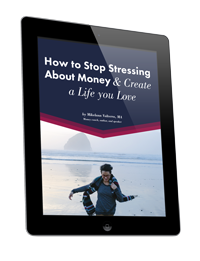 Every year in January I write about creating an annual spending plan. The metaphor I’ve used in past years is looking into your own “crystal ball” to see the future. (A few years ago I wrote this: Look Into Your Crystal Ball) And indeed, creating a spending plan for the whole year does allow you to see where you will end the year, before it starts. “If I spend this and earn that, I’ll have this much at the end of the year.”
Every year in January I write about creating an annual spending plan. The metaphor I’ve used in past years is looking into your own “crystal ball” to see the future. (A few years ago I wrote this: Look Into Your Crystal Ball) And indeed, creating a spending plan for the whole year does allow you to see where you will end the year, before it starts. “If I spend this and earn that, I’ll have this much at the end of the year.”
So here is a different metaphor: what if you had a magic road map? And what if this road map told you how to get to your destination — no debt, more fun experiences this year, and more savings perhaps??? AND it magically helped you come up with alternate routes throughout the year when you found your way blocked?
Last year I created my personal magic road map. I sat down a year ago and “mapped” out last year. I looked first at what I needed and wanted for the year. (Here’s my post on creating your needs/wants list: How to Create Your Own Needs and Wants List) I needed some work done on my house and the orthodontist was knocking on our door. I wanted to upgrade my wardrobe and do more travel. I wanted to fund my ROTH. So a year ago I came up with a workable plan.
Then throughout this past year, life threw me some curve balls. Life has away of doing that, you know. It became apparent that I had to get my son far more involved in an after school activity. He’s become a young teenager (danger Will Robinson). So we joined Crew – and now he rows five days a week for our local team. It’s a somewhat expensive sport, complete with some travel, so I had to bring other costs down to accommodate for it. But my magic road map allowed me to easily adjust. I did buy more clothes this year. Hurray! The house had different work done than I had anticipated though. Houses have a way of doing that. But I got my needs met and refused to compromise on my favorite wants – hair coloring and lawn help.
Actually, I may have reclassified hair coloring as a need and not a want. Yes, I could color my own hair, but I’ve decided professional help is a NEED since that bathroom color-stain incident.
The point is that my road map did indeed get me to the end of last year, in reasonably good shape, and with a minimum of financial stress. I felt in control, even as various roadblocks popped up. I was able to course-correct and navigate around them.
So I sat down last weekend and began mapping out the new year. I feel calm, in control and at peace. It’s magic.
Want more help transforming your relationship to money? Check out all the eBooks, audios, and more robust products Mikelann has created. Are you ready to break free of the “money fog” and step into earning what you are worth? Are you are ready to get in touch with your emotions so you never feel out of control around money again? Are you ready to love your financial life? Let Mikelann help you get there. Free items are at the top of the page.
